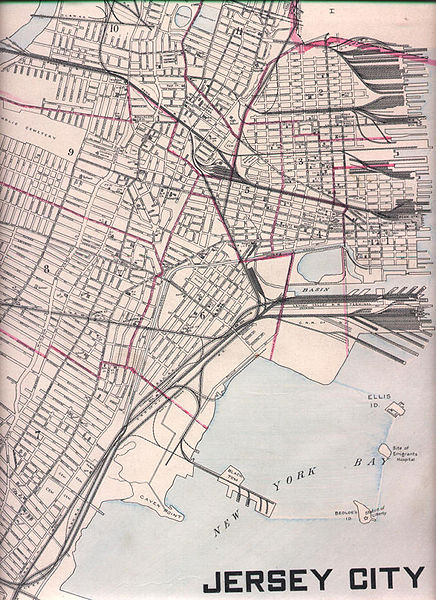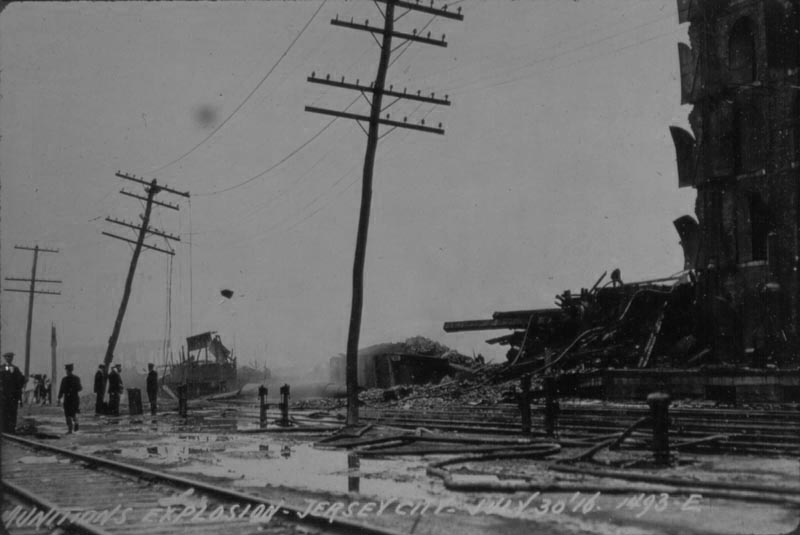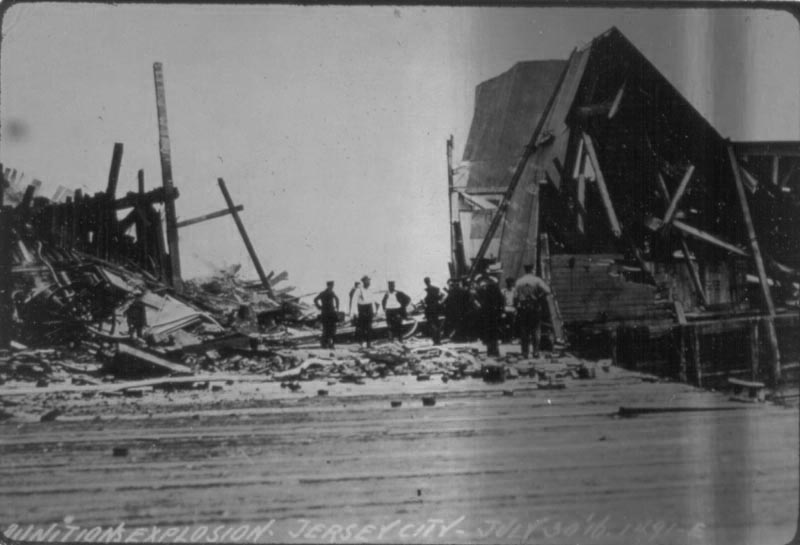L’explosion de Black Tom
source WIKIPEDIAL’explosion de Black Tom, survenue le 30 juillet 1916 à Jersey City dans le New Jersey, est un acte de sabotage réalisé par des agents de l’empire allemand visant l’approvisionnement en munitions américaines utilisées par les Alliés dans la Première Guerre mondiale. Le Black Tom qui était originellement une petit ile est alors un dépôt du port du New-York et New Jersey relié par un chemin de fer de la Lehigh Valley Railroad utilisé pour stocker les wagons de munitions en attente de transbordement.
 Carte de la région, le quai Black Tom est relié par un chemin de fer au continent. source WIKIPEDIA
Carte de la région, le quai Black Tom est relié par un chemin de fer au continent. source WIKIPEDIADes bombes incendiaires à retardement furent placé par le réseau du capitaine Franz von Rintelen sur le site qui abritait environ 1 000 tonnes d’explosifs dont du TNT embarqué à bord d’une barge. La déflagration fut suffisante pour briser les vitres sur une distance de 40 kilomètres ; on estime généralement sa force à 5,5 sur l’échelle de Richter. Les pertes humaines sont estimées entre 4 et 7 victimes, de nombreux blessés et les dégâts à 20 millions de dollars de l’époque soit 400 millions de dollars valeur 2010.
L’explosion endommagea la Statue de la Liberté. Une centaine de rivets cédèrent, entre autres dégâts. Depuis, la visite du bras et de la torche de la statue est interdite. Les réparations de la statue coûtèrent 100 000 dollars de l’époque (environ 2 millions en dollars 2010).
L’accès de Liberty Island fut interdit les dix jours suivant l’explosion et, pour réparer le flambeau, le gouvernement engagea le sculpteur Gutzon Borglum, qui conçut plus tard le mont Rushmore.
La société Lehigh Valley Railroad, conseillé par John J. McCloy, réclama le des dommages contre l’Allemagne à la Commission mixte des réclamations germano-américaine institué par le traité de paix de Berlin de 1921. La commission a déclaré en 1939 que l’Allemagne impériale avait été responsable des dommages. Les deux parties ont finalement convenue d’un accord sur 50 millions de dollars en 1953 (soit plus de 460 millions de dollars valeur 2012). Le paiement final a été effectué par l’Allemagne de l’Ouest en 1979.

This displays the picture and text of the Black Tom Explosion commemorative plaque found in Liberty State Park – source WIKIPEDIA
Aftermath of the Black Tom explosion, an act of sabotage on American ammunition supplies by German agents which took place on July 30, 1916 in Jersey City, New Jersey. source WIKIPEDIA


 Aftermath of the Black Tom explosion, an act of sabotage on American ammunition supplies by German agents which took place on July 30, 1916 in Jersey City, New Jersey. source WIKIPEDIA
Aftermath of the Black Tom explosion, an act of sabotage on American ammunition supplies by German agents which took place on July 30, 1916 in Jersey City, New Jersey. source WIKIPEDIA Black Tom Explosion (1916)
Black Tom Explosion (1916) http://www.state.nj.us/dep/parksandforests/parks/liberty_state_park/liberty_blacktomexplosion.html
Newspaper article from "The Jersey Journal" announcing the devastating news of the munitions explosion at Black Tom. Now a section of Liberty State Park (along Morris Pesin road including the park office and Flag Plaza), Black Tom was originally a small island in New York Harbor not far from Liberty Island. Between 1860 and 1880, Black Tom was connected to the mainland by a causeway and rail lines terminating at a freight facility with docks. The area between the island and the mainland was filled in sometime between 1905 and 1916 by the Lehigh Valley Railroad as part of its Jersey City facility. By the beginning of the twentieth century, Black Tom was serving as a major munitions depot.
Before the United States entered the First World War, American businessmen would sell their supplies to any buyer. However, by 1915, the British Navy had established a blockade effectively keeping the Germans from being able to buy from the American merchants. The German government, on July 30, 1916, orchestrated the sabotage of freight cars at Black Tom, which were loaded with munitions for the Allies in Europe.
The wreckage after the Black Tom Explosion. According to a recent study, the resulting explosion was the equivalent of an earthquake measuring between 5.0 and 5.5 on the Richter Scale. Windows within a 25-mile radius were broken, the outside wall of Jersey City’s City Hall was cracked and pieces of metal damaged the skirt of the Statue of Liberty (it is because of this explosion that the Lady’s torch has been closed off to visitors). Most of the immigrants on Ellis Island were temporarily evacuated. Losses were estimate at $20 million and seven people were killed.
After the war, a commission appointed to resolve American claims against Germany was established. It took years before a decision was made, finally in June of 1939, the commission ruled that the German Government had authorized the sabotage. However, World War II interrupted any chances of arranging for restitution. In 1953 the two governments finally settled on terms that the German government would pay a total of $95 million for a number of claims including Black Tom.
The final payment was received in 1979.
1916 – JCMC EMS Responds to Black Tom Explosion
http://www.libertyhealth.org/jcmcHistoricalData.aspx

A New York Times article about the Black Tom explosion.
http://superpupsays.typepad.com/superpup_says/2008/05/sabotage.html





